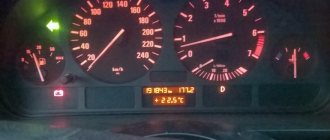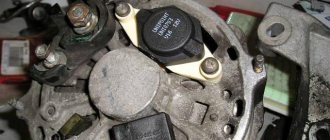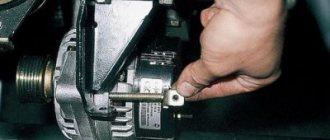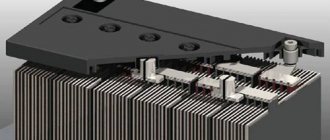Today I’ll tell you about one common problem and some ways to solve it. I have a problem: the battery light does not go out after starting the engine until you rev it up. The problem mainly manifests itself when the outside temperature drops. In summer it rarely appears. There are several reasons for this. I'm not the most electrical expert, so I'll describe it in simple words. One of the reasons is the lack of current to excite the generator at idle. The second reason is the diodes in the bridge. And the third is the voltage regulator (but this is not exact). The first step is to make sure that there is good ground going to the generator. The cause of lack of current is treated by adding a light bulb or resistance to the excitation circuit. This is a thin wire with a terminal that goes to a separate chip (alternatively, the terminal on this wire can barely hold on, then you just need to secure it well). This solution can be called temporary, because the additional resistor in the circuit replaces the resistor in the instrument panel, which is most likely burned out. The next possible reason is the additional diodes (small black ones) on the diode bridge. To do this, it is better to remove the diode bridge. If you remove it without removing the generator, then it is important not to fall in love with the textolite screw insulator washers. First you need to check the contact of the legs to the platforms, perhaps one has moved away. And then check the diodes themselves. To do this, you need to turn the multimeter into diode testing mode.
The numbers must be at least 500 or more. If less, then the diodes need to be replaced. It would be a good idea to check the voltage regulator. To do this, you need to attach a light bulb to the brushes of the regulator and apply voltage to it. When the voltage increases to 15V, the light should go out.
Please don't blame me for mistakes; I'm never an electrician myself))).
Each of you has probably noticed a little red box on the instrument panel indicating the battery. We all know that it lights up when you turn the key in the ignition and goes out when the engine starts. Why is this happening? When you insert the key and turn it in the ignition, automatic diagnostics of almost all engine systems (ABS, ESP, Airbag, Check Engine, etc.) occurs; after a successful self-test, the indicators go out, which indicates the serviceability of one or another system. The same is with the battery, when it is ok, the indicator goes out, in case of problems with the battery, the battery lamp lights up.
In this article, I will talk about why the battery light is on, as well as malfunctions that can cause the battery light to light up.
How to understand what exactly caused the light bulb to burn? How to fix the problem?
If the battery light is on while the engine is running, do not turn it off, open the hood and check the voltage at the battery terminals. If charging is supplied to the multimeter, the voltage should be 13.5-14.3V. If there is no charging, the voltage will be much lower - approximately 12V.
To solve the problem you will need:
- Two screwdrivers (flat and Phillips);
- “Control” (12V light bulb);
- Multimeter;
- Pliers, a knife and sandpaper to clean the contacts.
Breakdowns and their elimination
Let's say a voltmeter is installed in a car. And it shows that there is charging. The battery charging light also comes on periodically or does not light up at all. Measuring the voltage directly at the battery terminals shows exactly 12 volts. But the capacity is lost, the starter does not rotate, and the tape recorder has difficulty working. First of all, clean all the thick wires through which the battery is charged. Measure the voltage at terminal “30” of the generator. If it is larger than what is on the battery, strip the terminal or change the wire.
If the voltmeter on the dashboard shows the presence of charging, but the lamp does not light up, and the battery is discharged, despite the normal voltage in the on-board network, carry out a couple of simple steps. Turn on the maximum number of consumers and see how the voltmeter behaves. If the voltage drops sharply, tighten the alternator belt. It begins to slip because, under load, the rotor EMF counteracts the stator one. And it takes a lot of effort. In addition, one of the pulleys may simply wear out. Then even installing a new belt will not help.
Let's look at different situations in which the battery light comes on.
- Situation one - the on-board voltmeter shows the charge, the battery light does not light up, the multimeter shows 12V at the battery terminals, while the battery itself is completely discharged.
Treatment: We strip the high voltage terminals and wires, after which we measure the voltage again. If this does not lead to anything, check the voltage at the “30” terminal of the generator. Connect one electrode of the multimeter to the generator terminal, the second to ground. If in this case the voltage is slightly higher than on the battery, “stripping” the “30” terminal. If necessary, change the wire that goes from the generator to the battery.
- Situation two - the light and the light indicate charging, but the battery is discharged. The voltage on the battery is normal (
14V), but when there is a load (signal, headlights, etc.), the charging arrow jerks to the extreme left position. The reason is poor tension of the generator belt, or a problem with the pulley or bearing itself.
- In addition, the cause of the above situation may be a breakdown of one of the diodes or a break in the stator winding. Do the following - turn off the ignition, then check the diodes with a multimeter; if a breakdown is detected, replace them.
- It would be a good idea to check the generator brushes. To do this, simply remove the brushes and check their length, if the length is less than five mm. I recommend replacing the generator brushes.
- Situation three - after turning the key in the ignition, the battery lamp does not light up, while the charge sensor does not work, and the battery does not charge. The most likely cause is a blown fuse. It is designated “F10”, its rating is 10 Amp. If after replacing a new fuse you do not see any result, the reason may lie in the lock itself or the ignition relay.
- Situation four - after turning the key there is no charging, but all devices are functioning, the battery light does not light up.
Treatment: Remove the wiring from terminal “61” of the generator, and then connect it directly to the negative (that is, to the body). If after this the lamp lights up, the reason is in the excitation winding of the generator.
- The reason may also be poor contact in the connector. It is necessary to clean everything properly and check the result; if it is not there, it is very possible that the lamp has burned out. If the problem is not in the light bulb (it burns dimly or intermittently), then other indicators will also light dimly or intermittently; if this only happens with the battery indicator, then perhaps the reason is in the light bulb itself.
- Situation five - after turning on the ignition, the battery light comes on, and after starting the engine it does not go out, while charging is either intermittent or does not exist at all. The reason for this behavior may be poor contact of the wire with the connector on the dashboard.
What does this mean
After the owner of the car turns on the ignition by turning the keys, the on-board computer begins checking all systems and sensors of the car; the lights flash for a short time and then go out after the check. It’s the same with the battery indicator; if the indicator lights up, then you have a problem with the battery.
A battery (also abbreviated as AKB) is needed to start the engine. Power from it goes to the ignition system and to the starter when the engine starts. After the engine has already started, power begins to flow from the generator, and even if you remove the battery terminals, the engine will not stall. The battery releases its charge at startup and is then slowly recharged by the generator.
Not every driver knows about this, but why? Because the traffic regulations that he passed did not say anything to obtain a license to install a car. Of those who have received these rights, only every hundredth person understands the device at least a little, and not every five hundredth person who has received the right knows all the components and assemblies thoroughly. Therefore, those who say that you already know this do not understand the device themselves.
The generator produces a voltage that fluctuates within a narrow permissible range from 13.5 to 14.5 Volts so that the entire electrical circuit of the car works normally. The relay-regulator prevents the increase in voltage in the network; this relay reduces the voltage to the required value, regardless of the speed of the machine and engine speed.
When the voltage from the generator goes beyond these limits and the red light on the dashboard lights up. If you do not pay attention to this signal, your battery will run out, and then you will definitely not be able to start the engine. There is nothing good about increased stress either. Here the light bulbs and fuses can burn out, and this will only make things worse for the battery.
Why does the battery charging light not go out?
If, after starting the car's engine, the battery charge lamp continues to glow or is lit at full intensity, this indicates that all electrical systems are powered directly from the battery. This means that the car will continue to move until the battery is completely dead (about 2.5–3 hours, if you drive with the headlights, air conditioning, wipers, and audio system turned off).
The battery charge light comes on after the engine starts: why does this happen?
The reasons why the icon does not stop lighting in a timely manner may be:
- problems with the relay regulator or diode bridge;
- low tension of the alternator belt or its wear;
- blown fuse;
- poor battery terminal contacts;
- break in the generator circuit, partial or complete malfunction of the generator brushes or brush holders;
- failure of the ignition switch (not one, but several icons may light up at once, including the battery charge and catalyst overheat lamps, as well as a check).
Why the lamp does not go out when the car engine starts: video
Voltage regulator
Generators have two windings – rotor and stator. Moreover, the first one performs the functions of the excitation winding. We need to remember the theory: without a moving magnetic field, generating electricity is impossible. Therefore, it is enough to apply voltage to the rotor winding to obtain a magnetic field. Well, since the rotor is a moving part of an electric machine, it becomes clear that the magnetic field will rotate. And if the battery charging light periodically lights up, this indicates that there is a minor defect in the generator.
But why install a voltage regulator specifically in the power circuit of the excitation winding? After all, it is necessary to carry out stabilization in the stator circuit. This is true, but it’s worth remembering the theory: the output voltage depends on the magnitude of the magnetic field. Everything is very simple. It is enough to stabilize the power supply in the rotor winding circuit so that there are no oscillations at the output. It is much easier to stabilize small currents than large ones (can reach several tens of amperes).
The lamp works when the engine is on: how to identify the cause
Check how intensely the icon lights up and when it happens. Based on this, you will understand where the problem lies.
Constant light
Most likely, the problem is that the battery needs more charge while driving. The causes of this problem may also be:
- weakening;
- complete or partial wear of the alternator belt;
- regulator relay burnout;
- breakdown of generator brushes.
In any case, it is necessary to replace the failed element.
On turns
The problem lies in the diode bridge or in another system. For the most accurate diagnosis, it is recommended to seek help from specialists.
At high speeds
The slip rings are worn out. The problem may also be caused by a poorly tensioned alternator belt, faulty bearings or alternator brushes.
Idling
To find a defect, you need to examine the alternator belt, regulator and diode bridge. If the indicator is bright, start checking from the bridge; if it is bright, start checking from the relay.
Blinks, lights up periodically, dims
A flashing (dim) pictogram indicates abrasion of the copper armature rings or generator brushes. You need to stop using worn out parts and buy new ones.
Troubleshooting
Let's say that after starting the engine you notice that the battery charging light comes on. VAZ is susceptible to this problem, and it is relevant for any model. The following components need to be checked:
- Voltage regulator described above. On some vehicles it may be installed under the hood rather than inside the alternator.
- Diode bridge. One or more semiconductors may fail.
- Generator drive belt. It may be poorly tensioned, or it may have broken or slipped. If you hear a whistle, then you can judge that the bearing in the front cover is broken.
How to fix a problem that caused the battery charge lamp to light up
If the voltmeter on the instrument panel and the battery lamp indicate a gradual increase in charge, and the battery itself is “empty”, but shows a voltage of 12–14V (which “falls” to the left when the headlights, turn signals and other devices are turned on), then the causes of the malfunction may be a decrease tension or wear of the generator belt.
If the generator brushes are worn, they need to be replaced.
Similar symptoms indicate wear on the generator brushes. The length of this element in good condition should not be less than 5 mm. To eliminate the problem of an “empty” battery, it is recommended to replace the alternator belt and brushes.
If the voltmeter readings indicate the presence of a charge, the voltage at the battery terminals is 12 V, but the battery itself is discharged, it is necessary to clean the terminals . This can be done using a knife, brush, sandpaper.
If the voltmeter indicates there is a charge, but the battery is discharged, you need to clean the terminals
It is also recommended to install new high voltage wiring.
The fact that the fuse has blown is indicated by the following behavior of the car: after turning the ignition, the battery icon does not light up and there is no current supply to the battery. In this situation, you have to replace the element.
If there is no charging, all devices work properly, but the battery light does not light up, you need to remove terminal 61 and connect it to the car body.
Terminal 61 location
If the icon remains lit, the cause of the malfunction is the generator activation winding. The problem may also lie in faulty contacts - you will have to clean them.
The following situation is also possible: the battery light lights up and does not go out after the engine starts, and charging either does not occur at all or periodically stops. Such behavior of the car indicates poor contact of the wire with the connector located on the dashboard.
Checking electrical equipment on Grant
Let's start by checking the alternator belt. As a rule, in 40% of cases it is he who is to blame - either it breaks or slips. The latter on Grant is only possible with engine 21126, where it can be adjusted.
If the belt is torn, it must be replaced with a new one.
If everything is in order with the belt, check the fuses in the engine compartment (in the fuse box). They are shown by arrows in the photo below:
We take them out and check for breaks or install others in their place that are known to be good. We try to start the engine and watch the warning light. If it goes out, the reason has been found and you can continue driving. If nothing has changed, we continue further.
Next, we check the power wires, which may be oxidized, broken or damaged. We will check everything that is connected to the “+” of the battery.
First, let's check the battery terminals themselves, their tightness and possible oxidation.
Let's check the connection to the starter. There may be some shortening.
Let's check the connection to the generator. It may be oxidized or loose.
So, after pulling all the wires and connections, we start the engine again. If the warning light goes off, we rejoice and continue driving.
Generator circuit open
When the battery light is on, check for an open circuit, the reasons for which may be:
- Poor contact between brushes and rotor rings. This is typical for car owners who do not properly monitor cleanliness under the hood. Over time, the connections become coated with dirt and oil, which increases the resistance in the field circuit. As a result, the generator power drops. To fix the problem, disassemble the device and clean the contacts with a rag previously soaked in gasoline, and check the brush assembly.
- Excitation winding is broken. At the junction of the winding ends and slip rings. The battery is not receiving a charge. The defect is detected with a voltmeter or tester. The devices are connected to the battery and checked to see if the light comes on and if the voltmeter needle has deviated. A negative result confirms a break. In this case, by connecting a probe to each coil and taking readings, a bad one is determined. The breakage area is sealed with a special product containing soft solder. If there is a break inside the system, the problematic coil is rewound or replaced.
- Interturn breakdown. The result of a violation of the insulation of the protective cable.
- Breakdown to the body. Determined by a 220V control. The probes are connected to the slip ring and the core. The control lights up when violated.
- Breakdown of rectifier diodes. The result of overheating.
Let's sum it up
As you can see, there are many reasons why problems arise with battery charging. In this case, the battery icon on the panel may often light up constantly, blink, or, conversely, not light up. To detect the cause, it is necessary to check individual elements step by step as discussed above.
Finally, we note that you first need to check the condition of the battery itself; the battery must be in full working order. At the same time, you should find out if there are any problems with the electrical equipment in the car, which could result in a rapid discharge of the battery during idle time.
If the battery is normal, there are no other hidden reasons for its discharge, then often the culprit is the generator, relay - regulator or bad contact. Moreover, after conducting qualified diagnostics, it is possible to identify, localize and efficiently eliminate the malfunction.
Generator belt
During load (optics light, radio on) with low belt tension, the battery quickly loses voltage. Signs of weakened tension are squealing and whistling, which is often observed when it is cold.
To clarify, check the degree of tension - measure the amount of deflection. First turn off the engine. According to the instructions, press on the part. Belt deflection of less than 5 mm is considered normal. If the deflection is greater, the part is tightened.
The manipulation does not cause any difficulties, especially in older cars and if there is an adjustment bar. Scroll the screw of the mechanism, which is usually located on top of the device. In this way, the generator is moved relative to the engine, creating the required tension.
In modern cars they are adjusted without a bar. For this:
- Loosen the generator fasteners;
- Turn the screws in a circle;
- Move the device away from the engine to the desired tension;
- Tighten the nuts.
At the end, check the degree of belt tension.
Internal breakdowns
The above situation can occur when a semiconductor diode fails. If there is a break in the stator winding, a voltage drop under load is also observed. Disassemble the generator and diagnose the semiconductors. They have one-way conductivity. Ring the stator windings to identify a short to the housing. It is worth noting that a break can be found with a multimeter, but a bad contact is unlikely. For this purpose it is better to use a megohmmeter.
It is worth inspecting the generator brushes as well. If the battery charging light comes on at low speeds when the light is on, this also indicates the presence of the breakdowns described above. A lot depends on the brushes too. If they are 5mm or less in length, you can safely throw them away. And if the battery charging light comes on due to brush failure, the fault is very easy to find.
Generator
At the first stage, the generator is checked. Possible causes of the malfunction include:
- Weak voltage connections. Often in the spring, after severe frosts, the compounds oxidize.
- Loose or broken drive belt. Modern cars control the parameter with a special sensor that sends information to the on-board computer.
- Malfunction of the diode bridge or pulley bearings.
- Worn slip rings or brushes.
A generator breakdown is known by its characteristic accompanying signs. Rapid battery discharge, extraneous noise while driving. A characteristic feature is a voltage drop during operation of consumer sources (dim light, slow operation of brushes, low volume of the radio). A common problem with old cars.











